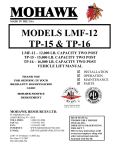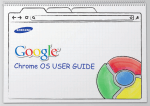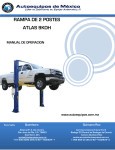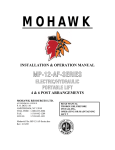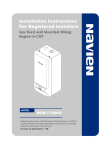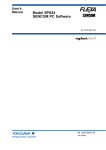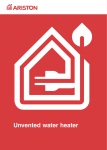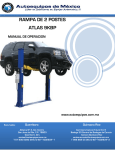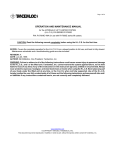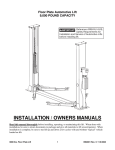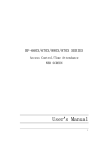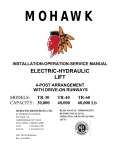Download MP-18 Series (Rev 10-2005)
Transcript
MOHAWK INSTALLATION & OPERATION MANUAL MP-18-SERIES ELECTRIC/HYDRAULIC PORTABLE LIFT 2, 4, 6 & 8 POST ARRANGEMENTS MOHAWK RESOURCES LTD. READ MANUAL THOROUGHLY BEFORE INSTALLING, OPERATING OR SERVICING THIS LIFT !! Deliver these instruction to lift owner/user/employer along with other instructional materials furnished with this lift. 65 VROOMAN AVENUE P. O. BOX 110 AMSTERDAM, NY 12010 TOLL FREE: 1-800-833-2006 FAX: 1-518-842-1289 LOCAL: 1-518-842-1431 Mohawk File: MP-18-Series – MOHAWK VERSION.doc Rev: 10/10/2005 1 IMPORTANT SAFETY INSTRUCTIONS When using this garage equipment, basic safety precautions should always be followed, including the following: 1. Read all instructions. 2. Inspect lift daily. Do not operate if it malfunctions or problems have been encountered. 3. Never attempt to overload the lift. The manufacturer’s rated capacity is shown on the identification label on the power side column. Do not override the operating controls or the warranty will be void. 4. Only trained and authorized personnel should operate the lift. Do not allow customers or bystanders to operate the lift or be in the lift area. 5. Position the lift support forks to contact the vehicle tires. Raise the lift until the forks contact the tires. Check forks for secure contact with the vehicle tires, then raise the lift to the desired working height. 6. NOTE: Always use all 4 posts to raise and support vehicle. 7. Note that the removal or installation of some vehicle parts may cause a critical load shift in the center of gravity and may cause the vehicle to become unstable. Refer to the vehicle manufacturer’s service manual for recommended procedures. 8. Always keep the lift area free of obstructions and debris. Grease and oil spills should always be cleaned up immediately. 9. Never raise vehicle with passengers inside. 10. Before lowering check area for any obstructions. 11. Before driving vehicle between the posts, position the lift forks to allow vehicle to freely enter lifting area. To not hit or run over forks as this could damage the lift and/or the vehicle. 12. Before removing the vehicle from the lift area, position the lift forks to allow vehicle to freely leave lifting area. To not hit or run over forks as this could damage the lift and/or the vehicle. 13. Care must be taken as burns can occur from touching hot parts. 14. Do not operate equipment with a damaged cord or if the equipment has been dropped or damaged – until a qualified serviceman has examined it. 15. Do not let cords hang over tables, benches or counters or come in contact with hot manifolds or moving fan blades. 16. If an extension cord is necessary, a cord with a current rating equal to or more than that of the equipment should be used. Cords rated for less current than the equipment may overheat. Care should be taken to arrange the cord so that it will not be tripped over or pulled. 17. Always unplug the equipment from electrical outlet when not in use. Never use the cord to pull the plug from the outlet. Grasp plug and pull to disconnect. 18. Let equipment cool completely before pulling away. Loop cord loosely around equipment when storing. 19. To reduce the risk of fire, do not operate equipment in the vicinity of open containers of flammable liquids (gasoline). 20. Adequate ventilation should be provided when working on operating internal combustion engines. 21. Keep hair, loose clothing, fingers, and all parts of body way from moving parts. 22. To reduce the risk of electrical shock, do not use on wet surfaces or expose to rain. 23. Use only as described in this manual. Use only manufacturer’s recommended attachments. 24. ALWAYS WEAR SAFETY GLASSES. Everyday eyeglasses have only impact resistant lenses, and they are NOT safety glasses. SAVE THESE INSTRUCTIONS ii Mohawk Number Total Lift ----------------- Fork Lengths ------------------Model Name of Posts: Capacity (lbs): Post 1&2 Post 3&4 Post 5&6 Post 7&8 MP-18-005 2 36,000 15" N/A N/A N/A MP-18-009 2 32,000 22" N/A N/A N/A MP-18-006 MP-18-018 MP-18-010 4 4 4 72,000 68,000 64,000 15" 15" 22" 15" 22" 22" N/A N/A N/A N/A N/A N/A MP-18-007 MP-18-024 MP-18-025 MP-18-011 6 6 6 6 108,000 104,000 100,000 96,000 15" 15" 15" 22" 15" 15" 22" 22" 15" 22" 22" 22" N/A N/A N/A N/A MP-18-008 MP-18-026 MP-18-027 MP-18-028 MP-18-012 8 8 8 8 8 144,000 140,000 136,000 132,000 128,000 15" 15" 15" 15" 22" 15" 15" 15" 22" 22" 15" 15" 22" 22" 22" 15" 22" 22" 22" 22" Notes: All Posts with 15" Forks are Rated 18,000 lbs each. All Posts with 22" Forks are Rated 16,000 lbs each. iii The Automotive Lift Institute (ALI) is a trade association comprised of US and Canadian manufacturers and certain national distributors of automotive lifts. For almost 50 years, the ALI in cooperation with the American National Standards Institute (ANSI) has continued to sponsor the national standard ANSI/ALI ALCTV-1998 "Safety Requirements for Construction, Testing, and validation for Automotive Lifts.” The new "ALI/ETL Automotive Lift Certification Program" is based on ALI developed methods and criteria for third party testing of automotive lifts to validate conformance with ANSI/ALI ALCTV- 1998. For automotive lifts to be certified, manufacturers must execute an agreement with the ALI and ETL / Intertek Testing Services and must meet certain requirements: ♦ Must be structurally tested in accordance with the test requirements as outlined in ANSI/ALI ALCTV- 1998. ♦ All motor operated units must be listed by a nationally recognized testing laboratory (NRTL) in accordance with ANSI/UL-201. ♦ The manufacturer's production facility must meet quality control requirements as set forth in the ANSI Z34.1-1987 and the ALI/ETL Automotive Lift Certification Program Procedural Guide. ♦ All manufacturer-provided instructions, manuals, and operator safety documents, must meet the requirements of the ANSI/ALI ALCTV–1998 and ANSI/UL-201. Lifts meeting these rigid requirements may be listed in the directory of certified lifts and be labeled with the "ALI/ETL certification mark" (Above on right), and, if applicable, the ETL listing mark to ANSI/UL-201. Mohawk has been a long-standing member of ALI and most of Mohawk’s popular models are currently listed and certified. Other Mohawk models are in various stages of testing. To obtain a complete and current certification listing, contact Mohawk Resources Ltd. To obtain a copy of the current automotive lift standard, contact ALI or ANSI. Some people purchase quality products and others do not. You are assured of quality when you purchase a Mohawk product in compliance with the certification program. iv HAVE A QUESTION? Call your local Mohawk distributor For parts, service and technical support. Distributor Place Card Here Please have this unit’s model and serial number when calling for service. Model Number ______________________ Serial Number ______________________ OR CONTACT: MOHAWK RESOURCES LTD. 65 Vrooman Ave. P.O. Box 110 Amsterdam, NY 12010 Toll Free: 1-800-833-2006 Local: 1-518-842-1431 Fax: 1-518-842-1289 Internet: www.MOHAWKLIFTS.com E-Mail: [email protected] v MOHAWK WARRANTIES EFFECTIVE DATE: 1/1/2006 * GENERAL WARRANTY INFORMATION: MOHAWK’S OBLIGATION UNDER THIS WARRANTY IS LIMITED TO REPAIRING OR REPLACING ANY PART OR PARTS RETURNED TO THIS FACTORY, TRANSPORTATION CHARGES PREPAID, WHICH PROVE UPON INSPECTION TO BE DEFECTIVE AND WHICH HAVE NOT BEEN MISUSED. DAMAGE OR FAILURE TO ANY PART DUE TO FREIGHT DAMAGE OR FAULTY MAINTENANCE IS NOT COVERED UNDER THIS WARRANTY. ALL WARRANTY CLAIMS MUST BE PERFORMED IN ACCORDANCE TO MOHAWK’S WARRANTY PARTS RETURN POLICY (CONTACT MOHAWK’S SERVICE DEPARTMENT FOR MORE INFORMATION). THIS WARRANTY DOES NOT COVER MIS-DIAGNOSING OF UNIT OR PARTS RETURNED THAT ARE NON-DEFECTIVE. THIS WARRANTY DOES NOT COVER ANY CONSEQUENTIAL OR INCIDENTAL DAMAGES INCLUDING, BUT NOT LIMITED TO, LOST REVENUES OR BUSINESS HARM. THIS EQUIPMENT HAS BEEN DESIGNED FOR USE IN NORMAL COMMERCIAL VEHICLE MAINTENANCE APPLICATIONS. A SPECIFIC INDIVIDUAL WARRANTY MUST BE ISSUED FOR UNITS THAT DEVIATE FROM INTENDED USAGE, SUCH AS HIGH CYCLE USAGE IN INDUSTRIAL APPLICATIONS, OR USAGE IN EXTREMELY ABUSIVE ENVIRONMENTS, ETC.. MOHAWK RESERVES THE RIGHT TO DECLINE RESPONSIBILITY WHEN REPAIRS HAVE BEEN MADE OR ATTEMPTED BY OTHERS. THIS WARRANTY DOES NOT COVER DOWNTIME EXPENSES INCURRED WHEN UNIT IS IN REPAIR. THE MODEL NAME AND SERIAL NUMBER OF THE EQUIPMENT MUST BE FURNISHED WITH ALL WARRANTY CLAIMS. THIS WARRANTY STATEMENT CONTAINS THE ENTIRE AGREEMENT BETWEEN MOHAWK RESOURCES LTD. AND THE PURCHASER UNLESS OTHERWISE SPECIFICALLY EXPRESSED IN WRITING. THIS NON-TRANSFERABLE WARRANTY APPLIES TO THE ORIGINAL PURCHASER ONLY. THIS WARRANTY IS APPLICABLE TO UNITS LOCATED ONLY IN THE UNITED STATES OF AMERICA AND CANADA. CONTACT MOHAWK RESOURCES LTD. FOR SPECIFIC WARRANTY PROVISIONS FOR UNITS LOCATED OUTSIDE OF THESE COUNTRIES. STRUCTURAL COMPONENTS (ALL LIFTS): ALL STRUCTURAL AND MECHANICAL COMPONENTS OF THIS UNIT ARE GUARANTEED FOR THE BELOW STATED TIME FRAME, SPECIFIC TO MODEL LISTED, FROM THE DATE OF INVOICE, AGAINST DEFECTS IN WORKMANSHIP AND/OR MATERIALS WHEN LIFT IS INSTALLED AND USED ACCORDING TO SPECIFICATIONS. 5-YEAR: 30. 3-YEAR: 2-YEAR: 1-YEAR: MODELS A-7, SYSTEM IA, SYSTEM IA-10, TOMAHAWK-9000, LMF-12, TP-15, TP-18, TP-20, TP-26, TPMODELS TR-19, TR-25, FL-25, TR-33, TR-35, TR-50, TR-75, TR-110, MP-SERIES, RP-SERIES LIFTS. MODELS PARALLELOGRAM SERIES LIFTS. MODELS HR-6, TD-1000, CT-1000, USL-6000. POWER UNIT (ALL LIFTS): ALL POWER UNIT COMPONENTS (MOTOR, PUMP AND RESERVOIR) ARE GUARANTEED FOR TWO YEARS FOR PARTS ONLY (EXCLUDING LABOR), FROM THE DATE OF INVOICE, AGAINST DEFECTS IN WORKMANSHIP AND/OR MATERIALS WHEN THE LIFT IS INSTALLED AND USED ACCORDING TO SPECIFICATIONS. HYDRAULIC CYLINDERS (MODEL SPECIFIC LIFTS): SEE MOHAWK’S “EXTENDED LIFETIME CYLINDER WARRANTY” FOR SPECIFIC WARRANTY PROVISIONS FOR HYDRAULIC CYLINDERS. THE “EXTENDED LIFETIME CYLINDER WARRANTY” IS APPLICABLE TO THE FOLLOWING MOHAWK LIFTS ONLY: A-7, SYSTEM IA, SYSTEM IA-10, LMF-12, TP-15, TP-18, TP-20, TP-26, TP-30. ALL OTHER MODELS ARE GUARANTEED FOR TWO YEARS (EXCEPT HR-6, WHICH IS ONE YEAR) FOR PARTS ONLY (EXCLUDING LABOR), FROM THE DATE OF INVOICE, AGAINST DEFECTS IN WORKMANSHIP AND/OR MATERIALS WHEN THE LIFT IS INSTALLED AND USED ACCORDING TO SPECIFICATIONS. ELECTRICAL COMPONENTS (ALL LIFTS): ALL ELECTRICAL COMPONENTS (EXCLUDING MOTOR) ARE GUARANTEED FOR ONE YEAR FOR PARTS ONLY (EXCLUDING LABOR), FROM THE DATE OF INVOICE, AGAINST DEFECTS IN WORKMANSHIP AND/OR MATERIALS WHEN THE LIFT IS INSTALLED AND USED ACCORDING TO SPECIFICATIONS. PNEUMATIC-AIR COMPONENTS (ALL LIFTS): ALL PNEUMATIC (AIR) COMPONENTS (I.E. AIR CYLINDERS AND POPPET AIR VALVES) ARE GUARANTEED FOR ONE YEAR FOR PARTS ONLY (EXCLUDING LABOR), FROM THE DATE OF INVOICE, AGAINST DEFECTS IN WORKMANSHIP AND/OR MATERIALS WHEN THE LIFT IS INSTALLED AND USED ACCORDING TO SPECIFICATIONS. STANDARD OPTIONS (ALL LIFTS): ALL STANDARD OPTIONS OF THIS UNIT ARE GUARANTEED FOR ONE YEAR FOR PARTS AND LABOR, FROM THE DATE OF INVOICE, AGAINST DEFECTS IN WORKMANSHIP AND/OR MATERIALS WHEN LIFT IS INSTALLED AND USED ACCORDING TO SPECIFICATIONS. vi SPECIAL AND/OR CUSTOMIZED LIFTS AND OPTIONS: ALL “SPECIAL” LIFTS AND/OR “CUSTOMIZED” OPTIONS ON THIS UNIT ARE GUARANTEED FOR ONE YEAR FOR PARTS ONLY (EXCLUDING LABOR), FROM THE DATE OF INVOICE, AGAINST DEFECTS IN WORKMANSHIP AND/OR MATERIALS WHEN THE LIFT IS INSTALLED AND USED ACCORDING TO SPECIFICATIONS. WARRANTY EXCEPTIONS (ALL LIFTS): ADJUSTMENTS: THIS WARRANTY DOES NOT COVER CASUAL AND ROUTINE ADJUSTMENTS SUCH AS, BUT NOT LIMITED TO: FITTINGS, J-BAR ADJUSTMENTS, ANCHOR BOLT RE-TIGHTENING, OR ANY SHIMMING OR ADJUSTMENTS REQUIRED DURING A PROPER AND PROFESSIONAL INSTALLATION BY A QUALIFIED INSTALLER. MAINTENANCE AND INSPECTIONS: IF THIS UNIT IS NOT MAINTAINED AND INSPECTED IN ACCORDANCE TO THE RELEVANT SECTIONS IN THE USERS MANUAL FOR THIS SPECIFIC MODEL, WARRANTY IS SUSPENDED UNTIL THE LIFT CONDITION IS PROVEN TO BE TO MOHAWK’S SATISFACTION (ANY CURRENT CLAIMS WILL NOT BE PAID UNTIL THIS REQUIREMENT IS MET). OSHA, ANSI AND MOHAWK REQUIRE THAT RECORDS MUST BE MAINTAINED TO PROVE THAT INSPECTIONS AND MAINTENANCE OF THIS UNIT HAVE BEEN ROUTINELY PERFORMED BY QUALIFIED INDIVIDUALS. ABUSE: IF THIS UNIT IS FOUND TO BE OVERLOADED (PURPOSELY OR UNKNOWINGLY), USED IN A SITUATION BEYOND ITS INTENDED FUNCTION, NOT MAINTAINED OR INSPECTED REGULARLY, OR USED IN AN ABUSIVE ENVIRONMENT, ETC., THIS WARRANTY IS VOID IN ITS ENTIRETY. NON-EXISTENT PROBLEMS: FOR SERVICE VISITS, PART REPLACEMENTS, LABOR, ETC. FOR PARTS FOUND TO BE NON-DEFECTIVE, OR FOR A UNIT DIS-FUNCTION THAT DOES NOT EXIST, IT IS THE LIFT OWNER THAT REQUESTED THE SERVICE VISIT WHO BEARS THE RESPONSIBILITY OF ALL RELATED EXPENSES. * THIS WARRANTY SUPERSEDES ALL OTHER WARRANTY POLICIES PREVIOUSLY STATED AND IN ALL OTHER MOHAWK PRODUCT SPECIFIC LITERATURE (MANUALS, BROCHURES, ETC.). vii CONTENTS TEXT PAGE GENERAL NOTES & WARNINGS POWER SUPPLY REQUIRMENTS OPTIONAL EQUIPMENT LIFT SPECIFICATIONS (15” FORK MODEL) LIFT SPECIFICATIONS (22” FORK MODEL) DESIGN & CONSTRUCTION FEATURES MOBILE LIFT SET-UP MOBILE LIFT OPERATION SAFETY TIPS MAINTENANCE INSTRUCTIONS EXPLANATION OF COMPUTER SYSTEM TROUBLE SHOOTING MAINTENANCE & SERVICE CHART 1 2 3 4 5 6 7-8 9-10 11 12 13 14-15 16 PARTS DWG NO. MASTER POST ASSEMBLY (15” FORKS) SLAVE POST ASSEMBLY (15” FORKS) MASTER POST ASSEMBLY (22” FORKS) SLAVE POST ASSEMBLY (22” FORKS) JACK ASSEMBLY POWER UNIT ASSEMBLY FLOOR ROLLER ASSEMBLY LOCK ASSEMBLY CARRIAGE ASSEMBLY CYLINDER ASSEMBLY MASTER BOX ASSEMBLY MASTER PANEL ASSEMBLY SLAVE BOX ASSEMBLY SLAVE PANEL ASSEMBLY COMMUNICATION CABLE ASSEMBLY POWER CABLE ASSEMBLY DUMMY PLUG (A-YELLOW) ASSEMBLY DUMMY PLUG (B-RED) ASSEMBLY STRING POT ASSEMBLY PENDANT ASSEMBLY (OPTIONAL) MP-0400-A-010 MP-0400-A-011 MP-0400-A-012 MP-0400-A-013 MP-0400-A-003 MP-0400-A-004 MP-0500-A-001 MP-0600-A-001 MP-0700-A-001 MP-0900-A-001 MP-1300-A-003 MP-1300-A-004 MP-1300-A-012 MP-1300-A-013 MP-1300-A-005 MP-1300-A-006 MP-1300-A-010 MP-1300-A-011 MP-1300-A-014 MP-1300-A-020 ILLUSTRATIONS JACK OPERATION JACK RELIEF SETTING MASTER AND SLAVE ENCLOSURE PARTS DESCRIPTIONS CABLE IDENTIFICATIONS WARNINGS PICTOGRAM CAUTIONS PICTOGRAM SAFETY INSTRUCTIONS PICTOGRAM SCHEMATICS DWG NO. HYDRAULIC SCHEMATIC ELECTRICAL SCHEMATIC (3 PHASE STANDARD) POWER SWITCHING CIRCUIT DIAGRAM MASTER BOX WIRING (3 PHASE) SLAVE BOX WIRING (3 PHASE) ENCLOSURE DOOR WIRING ELECTRICAL SCHEMATIC (1 PHASE OPTIONAL) MASTER BOX WIRING (1 PHASE OPTIONAL) SLAVE BOX WIRING (1 PHASE OPTIONAL) MP-1400-A-002 MP-0400-A-001 (Pg 1 of 2) MP-0400-A-001 (Pg 2 of 2) MP-0400-A-003 (Pg 1 of 2) MP-0400-A-003 (Pg 2 of 2) MP-0400-A-004 MP-0400-A-006 MP-0400-A-008 (Pg 1 of 2) MP-0400-A-008 (Pg 2 of 2) OPTIONS ALL INFORMATION, ILLUSTRATIONS, AND SPECIFICATIONS IN THIS MANUAL ARE BASED ON THE LATEST PRODUCT INFORMATION AVAILABLE AT THE TIME OF PRINTING. WE RESERVE THE RIGHT TO MAKE CHANGES AT ANY TIME WITHOUT NOTICE. viii GENERAL NOTES & WARNINGS RECOMMENDATIONS BY THE INDIVIDUAL USER OR USING ORGANIZATION FOR IMPROVING THIS PUBLICATION OR ANY ASPECT OF THE PRODUCT ARE ENCOURAGED AND SHOULD BE FORWARDED IN WRITING TO: MOHAWK RESOURCES LTD, SERVICE DEPT, 65 VROOMAN AVENUE, AMSTERDAM, NY 12010 THIS IS NOT A VEHICLE LIFTING PROCEDURE MANUAL AND NO ATTEMPT IS MADE OR IMPLIED HEREIN TO INSTRUCT THE USER IN LIFTING METHODS PARTICULARLY TO THE INDIVIDUAL APPLICATION OF THE EQUIPMENT DESCRIBED IN THIS MANUAL. RATHER, THE CONTENTS OF THIS MANUAL ARE INTENDED AS A BASE LINE FOR OPERATION, MAINTENANCE, TROUBLE SHOOTING, AND PARTS LISTING OF THE UNIT AS IT STANDS ALONE AND AS IT IS INTENDED AND ANTICIPATED TO BE USED IN CONJUNCTION WITH OTHER EQUIPMENT. PROPER APPLICATION OF THE EQUIPMENT DESCRIBED HEREIN IS LIMITED TO THE PARAMETERS DETAILED IN THE SPECIFICATIONS AND THE USES SET FORTH IN THE DESCRIPTIVE PASSAGES. ANY OTHER PROPOSED APPLICATION OF THIS EQUIPMENT SHOULD BE DOCUMENTED AND SUBMITTED IN WRITING TO MOHAWK RESOURCES LTD. FOR EXAMINATION. THE USER ASSUMES FULL RESPONSIBILITY FOR ANY EQUIPMENT DAMAGE, PERSONAL INJURY, OR ALTERATION OF THE EQUIPMENT DESCRIBED IN THIS MANUAL OR ANY SUBSEQUENT DAMAGES. DO NOT WELD, APPLY HEAT, OR MODIFY THIS EQUIPMENT IN ANY MANNER WITHOUT WRITTEN AUTHORIZATION FROM MOHAWK RESOURCES LTD. CERTAIN ALLOY OR HEAT-TREATED COMPONENTS MAY BE DISTORTED OR WEAKENED, RESULTING IN AN UNSAFE CONDITION. MOHAWK RESOURCES LTD. IS NOT RESPONSIBLE FOR DISTORTIONS, WHICH RESULT FROM WELDING ON THIS EQUIPMENT AFTER MANUFACTURING IS COMPLETED. UNAUTHORIZED WELDING, APPLICATION OF HEAT, OR MODIFICATION OF THIS EQUIPMENT VOIDS ANY AND / OR ALL APPLICABLE WARRANTIES COVERING THIS EQUIPMENT. ALL WARRANTIES APPLICABLE TO THIS EQUIPMENT ARE CONTINGENT ON STRICT ADHERENCE TO THE MAINTENANCE SCHEDULES AND PROCEDURES IN THIS MANUAL. KEEP ALL SHIELDS AND GUARDS IN PLACE. ENSURE ALL SAFETY MECHANISMS ARE OPERABLE. KEEP HANDS, FEET, AND CLOTHING AWAY FROM POWER-DRIVEN AND MOVING PARTS. WARNING DO NOT INSTALL THIS UNIT IN A PIT OR DEPRESSION DUE TO FIRE OR EXPLOSION RISK IMPORTANT NOTE A LEVEL FLOOR IS SUGGESTED FOR A PROPER INSTALLATION SITE AND WILL ENSURE LEVEL LIFTING. ANY MAJOR SLOPE CHANGES WILL AFFECT THE UNIT’S LEVEL LIFTING PERFORMANCE. IF A FLOOR IS OF QUESTIONABLE SLOPE, CONSIDER A SURVEY OF THE SIGHT AND / OR THE POSSIBILITY OF POURING A NEW LEVEL CONCRETE SLAB SECTION. SIMPLY STATED, FOR OPTIMUM LEVEL LIFTING, THE EQUIPMENT, AT BEST, CAN LIFT ONLY AS LEVEL AS THE FLOOR ON WHICH IT IS LOCATED... AND SHOULD NOT BE EXPECTED TO COMPENSATE FOR DRASTIC FLOOR SLOPE DIFFERENCES. THIS EQUIPMENT MUST BE USED ON A LEVEL CONCRETE FLOOR WITH A MINIMUM THICKNESS OF 4-1/2” ON GRADE. THE CONCRETE MUST BE AGED AT LEAST (28) TWENTY EIGHT DAYS PRIOR TO INSTALLATION AND HAVE A MINIMUM COMPRESSIVE STRENGTH OF 3000 PSI. DO NOT USE THIS UNIT ON ANY ASPHALT SURFACE. DO NOT USE THIS UNIT ON A SECOND FLOOR OR ANY GROUND FLOOR WITH A BASEMENT BENEATH WITHOUT WRITTEN AUTHORIZATION FROM THE BUILDING ARCHITECT. CAUTION THE EQUIPMENT DESCRIBED IN THIS MANUAL COULD BE POTENTIALLY DANGEROUS IF IMPROPERLY OR CARELESSLY OPERATED. FOR THE PROTECTION OF ALL PERSONS AND EQUIPMENT, ONLY COMPETENTLY TRAINED OPERATORS WHO ARE CRITICALLY AWARE OF THE PROPER OPERATING PROCEDURES, POTENTIAL DANGERS, AND SPECIFIC APPLICATION OF THIS EQUIPMENT SHOULD BE ALLOWED TO TOUCH THE CONTROLS AT ANY TIME. SAFE OPERATION OF THIS EQUIPMENT IS DEPENDENT ON USE, IN COMPLIANCE WITH THE OPERATION PROCEDURES OUTLINED IN THIS MANUAL ALONG WITH THE MAINTENANCE AND INSPECTION PROCEDURES WITH CONSIDERATION OF PREVAILING CONDITIONS. THIS LIFT IS DESIGNED AND INTENDED FOR USAGE AND STORAGE INDOORS ONLY. MOHAWK DENIES ALL LIABILITY AND VOIDS WARRANTY IN SITUATIONS WHERE THIS LIFT IS USED OR STORED WHERE IT IS SUBJECTED TO THE OUTDOOR ELEMENTS AND TEMPERATURES. THE EQUIPMENT DESCRIBED IN THIS MANUAL IS NEITHER DESIGNED NOR INTENDED FOR ANY APPLICATION ALONE OR IN CONJUNCTION WITH ANY OTHER EQUIPMENT THAT INVOLVES THE LIFTING OR MOVING OF PERSONS. ALWAYS CONSULT THE VEHICLE LIFTING GUIDE FOR THE PROPER LIFTING POINTS ON ANY VEHICLE. THESE GUIDES ARE AVAILABLE FROM THE VEHICLE MANUFACTURERS. ALSO, REFER TO THE ANSI STANDARD “VEHICLE LIFT POINTS FOR SERVICE GARAGE LIFTING,” ANSI/SAE J2184-OCT92, SAFETY MANUAL “LIFTING IF RIGHT,” ALI/SM01, AND “VEHICLE LIFTING POINTS GUIDE” ALI/LP-GUIDE FOR PROPER POSITIONING OF VEHICLES ON LIFT. AFTER LIFTING THE VEHICLE TO THE DESIRED HEIGHT, ALWAYS LOWER THE UNIT ONTO THE MECHANICAL SAFETIES. THE FORMING OF GOOD OPERATIONAL WORK HABITS WILL ELIMINATE OVERSIGHTS IN THE USE OF PROVIDED SAFETY DEVICES. 1 POWER SUPPLY REQUIREMENTS IMPORTANT: It is user's responsibility to provide all wiring for electrical hook-up prior to installation and to insure that the electrical installation conforms to local building codes. Where required, it is the user responsibility to provide an electrical isolation switch (per lockout/tag-out requirements stated in ANSI Z244.1) located in close proximity to the lift that will enable emergency stop capability and isolate electrical power from the lift for any servicing requirements. The power supply connection must comply with the following. Disconnectable Cable Power Feed to Lift: If using a plug with the flexible cable connection provided, a plug must be provided that is rated as shown in the table below for the particular model, voltage and phase of the equipment supplied. This plug must be of the NEMA locking type with a ground connection and must have UL, CSA or other equivalent listing. Consult the plug manufacturer’s installation instructions for connecting the plug to the cable. Refer to the electrical schematics in this manual for the proper connection of the power supply to the lift. Refer below to wire color designations and proper selection of feed cable. Consult and adhere to all local and national codes applying to the installation and use of this product. Wire Color Designations: 3 Phase (Standard): Red: L1 (X) Black: L2 (Y) White: L3 (W) Green: Ground (G) 1 Phase (Optional): Red: L1 (X) Black: L2 (Y) White: Not Used (W) Green: Ground (G) Required Cable Specification: All power feed cable to this lift must be of Type SO, SOOW, or SOW, rated 600 V, 90 Degree C. The maximum length of the main power feed cable and interconnection means (plugs) must not exceed 30 feet from the main post to the power feed box. The plug must be provided that is rated as shown in the table below for the particular model, voltage and phase of the equipment supplied. 2 OPTIONAL EQUIPMENT Note: Refer to Option Equipment Section in the back of this manual for specific user instructions for option available for this lift. The standard mobile lift is suitable to lift wheeled vehicles by the tires. It normally comes in pairs of columns totaling 2, 4, 6 or 8 column systems. Ordering additional dummy plugs and power cables may enable one lift to be used in a variety of combinations simultaneously. A hand control pendant is available and can be connected to any master column. The standard power supply requirements for the MP-18 series mobile lifts is 208-230 VAC, 3 phase. Optional power supply configurations of 208-230 VAC, Single Phase or 480 VAC, 3 Phase or 575 VAC, 3 Phase are available upon request. Note: Refer to Power Supply Requirements section in this manual for availability with respect to post configurations. If it is desired to raise the vehicle by the frame, this can be done by using optional chassis lifting beams or optional frame contact adapters. The chassis lift beam fits into the cradle where the tire would normally fit and spans between a pair of columns. Frame contact adapters convert a pair of mobile lift columns into a 2-column frame engaging lift. Refer to the ANSI standard “Vehicle Lift Points for Service Garage Lifting,” ANSI/SAE J2184-Oct92, safety manual “Lifting if Right,” ALI/SM01, and “Vehicle Lifting Points Guide” ALI/LP-Guide for proper positioning of vehicles on lift. If it is desired to raise fork trucks, a fork truck adapter kit is available, which converts a pair of mobile lift columns into a 2-column pad engaging lift. For lifting applications involving side wing plows or RV’s with side extensions, where the forks of the mobile lifts can not reach to the tires, wing plow adapters are available. These adapters span between a pair of columns to achieve engagement of the tires in the same manner of the column forks. For lifting of vehicles with dual tires, floatation tires, or “super singles”, longer forks are available. Note that the longer fork lifts have reduced capacity. Jack Stands are also available that support the vehicle in the raised position for maintenance or to permit using the lift for other vehicles. NOTE: The use of any adapters on this lift may reduce the capacity of this lift. Refer to the capacities of the adapters used. WARNING! Use only options manufactured by MOHAWK RESOURCES LTD with this lift. Options manufactured by others and used on this lift may result in bodily harm, damage to lift and other equipment, and will void lift warranty, Mohawk Resources Ltd liability, and the ALI certification of the lift. 3 DESIGN AND CONSTRUCTION The standard mobile lift is suitable to lift wheeled vehicles by the tires. It normally comes in pairs of columns totaling 2, 4, 6 or 8 column systems. Each column consists of a rigid frame of three-wheel design for maneuverability, lifting carriages with tire forks, control panel, electrichydraulic power unit, and hydraulic cylinder. Two of the wheels are spring loaded and in fixed positions on the column base. The third wheel is steerable and hydraulically operated, permitting movement of the unloaded columns, but allowing the column to sit firmly on the floor before a load is applied. The Master Column (#1, #3, #5 or #7) accepts the incoming electrical supply to the Master Column Panel and has electrical outlets for the remaining columns. When the lift is raised or lowered in the “synchronized” mode the actual movement of each carriage is counted by each post’s PLC (programmed logic controller). If the movement of any carriage exceeds that of any other carriage in the system, the carriage is slowed down or stopped until the others catch up. The each post houses the same controls, enabling the user to control the whole lift, a single post or a post-pair combo at any post desired. A hydraulic cylinder, powered by an electric-hydraulic pump unit, controls the carriage movement. There is an internal relief valve on the pump unit, which prevents overloading of the carriage. A separate automatically engaging back-up mechanical safety lock latch prevents lowering of the carriage in the event of failure of the hydraulic system. All movement controls are of the “dead-man” type which are operable only as long as the operator is depressing the button. As soon as the button is released the motion will stop. All columns have controls for synchronized or individual column movement, plus an “Emergency Stop”. Depressing the Emergency Stop button will stop all columns immediately and will not permit any column movement until the depressed button is reset. 6 MOBILE LIFT SET-UP THOROUGHLY READ THIS SECTION BEFORE OPERATING THE LIFT. IF YOU HAVE ANY QUESTIONS GET THEM ANSWERED BEFORE PROCEEDING. REFER TO ANSI/ALI ALIS “SAFETY REQUIREMENTS FO INSTALLATION AND SERVICE OF AUTOMOTIVE LIFTS.” 1. Be sure that the floor is strong enough to support the lift before operating. Do not use the lift on asphalt surfaces, as the lift will sink (cause depressions in the asphalt) if the vehicle is on the lift for any extended period of time. Minimum recommended flooring is 4 ½” thick concrete with 3000 psi compressive strength on grade. If it is necessary to use the lift on an asphalt surface, it is recommended to use a steel plate, a minimum thickness of 3/8” (8mm) which extends a minimum of 6” on all sides beyond the support points of the base of the lift. This will minimize sinking effect if the vehicle is raised for an extended period of time. 2. Be sure that the surface of the floor is relatively flat. If there is a slope of more than 3 degrees (1 inch decline over 20”) do not operate the lift. Relocate to a flatter surface. 3. Verify adequate ceiling clearance to raise the vehicle without the top of the vehicle coming in contact with any obstruction. If necessary, measure the lowest point to determine how high you can raise the vehicle. Minimum height required is tallest vehicle height plus 67” 4. Drive the vehicle to the working spot. Do not drive the vehicle over the cables of the lift. The cables should be arranged in a “U” shape around the entry of the vehicle or the cables should be disconnected and stored before moving the vehicle. 5. Ensure posts pairs are opposite each other at each axle (Post Pairs are 1&2, 3&4, 5&6, 7&8). Push the cradle forks of each post around each tire. Be sure to push them in as far as possible. The wheel rim should be larger than the opening in between the forks. See figure below. Ensure that fork pins are placed in holes at fork tubes. 7 6. Press the release lever to lower all jacking wheels on back of all posts after positioning. 7. Connect the communication cables from post to post in a daisy-chain fashion. For example: Posts 1 to 3 to 4 to 2 for a 4-post setup. Place dummy plugs (one red and one yellow) at the posts at the end of the chain. (See figure below) Note: this lift will not power up unless all communication cables and both dummy plugs are connected. 8. Connect the power cable to the appropriate master column. (See figure above) 8 MOBILE LIFT OPERATION 1. Perform Lift Setup as stated in previous section. 2. Disengage all E-STOP buttons at each post by turning them clockwise to release them. Turn on the main switch to the lift at the powered column (column that has the main power cable connected to it). All fault lights will illuminate at each post for approximately 5 seconds. They will then flash, signaling the user that the posts system is initialized and ready. Press the RESET button. All fault light (red) should turn off, and all power lights (green) should turn on. They system is now ready to operate. 3. SINGLE WHEEL OPERATION Go to each wheel and engage each tire with the forks. To raise only a single wheel, turn the selector switch to SINGLE at the post that control is desired, while pressing the RAISE button. The SINGLE operation is to be used only to initially engage the tires and for slight equalization adjustments. During lift operation, is single wheel lifting, lowering or parking is desired, turn the selector switch to SINGLE at the post that control is desired, while pressing the RAISE button. BE VERY CAREFUL WHEN DOING THIS OPERATION THAT THE VEHICLE REMAINS STABLE AND THAT THE SIDE OF THE VEHICLE DOES NOT COME IN CONTACT WITH THE COLUMN. NOTE: If the SINGLE switch is released while the UP or DOWN button is still pressed the hoist will operate in default ALL synchronized mode (All posts will be controlled). 4. RAISING ALL WHEELS This lift controls default to controlling ALL the columns in the system (selector switch is spring returned to ALL). Press the RAISE button to raise the lift. Keep the pressure on the button until the vehicle is raised to the desired position. If necessary, use a second person to observe the area not seen by the operator. 5. PARKING ALL WHEELS (ON MECHANICAL LOCKS) This lift controls default to controlling ALL the columns in the system. Press the PARK button to lower the lift onto the mechanical locks. Keep the pressure on the button until the vehicle is completely lowered onto the locks. If necessary, use a second person to observe the area not seen by the operator. 6. LOWERING ALL WHEELS This lift controls default to controlling ALL the columns in the system. Press the LOWER button to lower the lift. Keep the pressure on the button until the vehicle is lowered to the desired position. If necessary, use a second person to observe the area not seen by the operator. NOTE: If lift in park position (on mechanical locks), you will have to raise lift off of locks first, then lower. Lift will not automatically rise off of lock when pressing lower. 9 7. PAIR OPERATION To raise, lower or park only a pair of wheels, turn the selector switch to PAIR at the post pair that control is desired, while pressing the RAISE, LOWER or PARK button. NOTE: Be sure that the set of wheels on the ground is free to move as the effective distance between the front and rear wheels becomes less as one pair of wheels is higher or lower than the other pair. Keep the height difference between pairs as low as practical. NOTE: If the PAIR switch is released while the UP or DOWN button is still pressed the hoist will operate in default ALL synchronized mode (All posts will be controlled). 8. RESET OPERATION To re-establish a respective post-to-post synchronized state of the lift (whether all carriages are perfectly level with each other or not), press and hold the RESET button for 5 seconds. The system will then think that all posts are level with each other in the relative state that they are in. This feature is often used after major SINGLE and PAIR operations have altered the synchronized state and the user wishes to re-establish level condition when lift fully lowered. This feature is also used to turn off faults. LIFTING EXAMPLE: Now that all the setup and operations instructions have been presented, an example of a typical lifting application is shown: A mechanic is to perform maintenance on a school bus. He drives the vehicle into the bay. He jacks each post with the pallet jack and moves them to each of the tires in the post configuration shown in the setup diagram. Pushing the posts firmly against the tires, he checks to ensure that the forks are slid inward as far as possible to engage the tires. He presses the pallet jack release on each column. He then connects the communication cables and dummy plugs to all the posts as shown in the setup diagram. He then connects the power cable to a master post, as shown in the setup diagram. He is now ready to use the lift. He turns the main power switch at the powered post. He then goes to each of the posts to ensure that the E-Stop buttons are released. Once this is done, all the fault lights should illuminate. He waits until the fault lights start blinking, signifying that the lift system is established, then he presses and holds the RESET button until all fault lights go off and all power lights come on. The lift system is now ready to operate. The mechanic then goes to each post and presses UP and SINGLE for a short moment to engage each tire with the forks until the spring loaded wheels of the post retract and the post feet are flattened on the floor. (The SINGLE function is to be used for slight adjustments and to initially engage the tires ONLY). The mechanic then presses UP and raises the vehicle to the desired height. Then the PARK button is pressed and held until the vehicle stops on the mechanical locks. Holding the PARK button too long will result in a “loss of motion” fault, which the RESET button can clear. The mechanic is now able to work on the vehicle. Once done, he presses UP to lift the vehicle off of the mechanical locks. The DOWN button is pressed to lower the lift to the ground. If any adjustments where made (like SINGLE or PAIR) which made the lift level vary from the floor level, the lift may experience a fault when lowered to the floor. Pressing RESET will clear this fault and allow further lowering. Also, reversing the adjustments by pressing SINGLE or PAIR will allow the user to lower the lift fully to the floor. Once vehicle is fully lowered, cables are stored and posts are jacked and pulled away. 10 AUTOMOTIVE LIFT SAFETY TIPS Post these safety tips where they will be constant reminder to your lift operator. For information specification to the lift, always refer to the lift manufacturer’s manual 1. Inspects your lift daily. Never operates if it malfunctions or if it has broken or damaged parts. Repairs should be made with original equipment parts. 2. Operating controls are designed to close when released. Do not block open or override them. 3. Never overload your lift. Manufacturers rated capacity is shown on nameplate affixed to the lift. 4. Positioning of the vehicle and operation of the lift should be done only by trained and authorized personnel. 5. Never raise vehicle with anyone inside it. Customers or bystanders should not be in the lift. During operation. 6. Always keep lift area free of obstructions, grease, tools, trash and other debris. 7. Before driving vehicle over lift, position arms and supports to provide unobstructed clearance. Do not hits or run over the lift arms, adapters, or axle supports. This could damage the lift or vehicle. 8. Load vehicle on lift carefully. Positioning lift supports to contact at the vehicle manufacturers recommended lifting points. Raise lift until supports contact the vehicle. Check supports for secure contact with vehicle. Raise lift the desired working heights. CAUTION: if you are working under the vehicle, lift should be raised high enough for locking device to be engaged. 9. Note that with some vehicles, the removal (or installation) of components may cause a critical shift in the centre of gravity and results in raised vehicle instability. Refer to the vehicle manufacturers service manual for recommended procedures when vehicle components are removed. 10. Before lowering lift, be sure tool trays, stands, etc. are removed from under the vehicle. Release locking devices before attempting to lower lift. 11. Before removing vehicle from lift area, position lift arms and supports to provide and unobstructed exit (refer back to No. 7) These “Safety Tips” along with “Lifting it Right” a general lift safety manual, are presented as an industry service by the Automotive Lift Institute. For more information on this topic, writes to ALI, PO Box 85, Cortland, NY 13045 11 MAINTENANCE INSTRUCTIONS 1. The channel sections where the carriage bearings ride against should be cleaned and lubricated twice a year (once every 6 months) using a light lubricant (WD-40). The channel sections where the slide blocks ride against should be cleaned and lubricated twice a year (once every 6 months) using a light lubricant (WD-40). 2. The main carriage bearings are factory lubricated and do not require any additional periodic lubrication. However, if additional lubrication is desired on these under the customer’s own inspection and maintenance program, it is recommended to use CAM2 – Multipurpose #2 Grease (Part No. 86035) or equivalent. Use approximately 2 oz. per bearing. 3. Weekly, or whenever the hoist is used after any extended down time, the power supply and communication cables should be checked to make sure that there are no nicks or cuts which may reduce or compromise the insulation. Use a de-greasing cleaner to clean all cables so they maintain their visibility (Ensure cables are disconnected when cleaning them and do not spray cleaner on end connections). Also, check visually the hydraulic line connections for leaks and tighten or repair as necessary. 4. The hydraulic fluid should be changed once every two years using new Dexron III ATF. Drain the reservoir tank only when the carriage is in the lowered position. Fill with 3.25 US gallons per reservoir. 5. Every three months check snap rings on wheels and carriage lock. Apply a light coating of lubricant to pins as needed (WD-40). 6. In case of electrical break down have qualified service personnel service the lift using only factory direct replacement parts. 7. Call your Distributor or Factory direct if you have any questions with regards to operating the lift or need of replacement parts. NOTE: ONLY TRAINED LIFT SERVICE PERSONNEL ARE PERMITTED TO REPLACE WORN OR BROKEN PARTS. REPLACE FAULTY PARTS WITH GENUINE RESOURCES LTD. FACTORY DIRECT PARTS ONLY. 12 MOHAWK EXPLANATION OF COMPUTER SYSTEM Electrical Power System There are two types of columns with this system, master and slave. The only difference between them is that the master columns allow main power entry and main power control. Once the power is feed a master column, a low power 24 VAC signal is sent through the system to detect if the following conditions are met: 1. The main switch of the master column with the power cable connected is turn on. 2. All the communication cables are connected to all the columns in the system. 3. Both dummy plugs are connected at the ends of the system. 4. All the E-stop buttons are released. Once these conditions are met, the main power contactor at the powered master column is activated, allowing power distribution to all the columns in the system. Power is provided to all the PLCs (programmed logic controllers) in the system. Once the PLCs are powered, they “search” for each other, establishing a network for synchronizing and controlling the lift as a system. Operation of Synchronized Lifting or Lowering Each PLC is “addressed” which establishes its identity on the network. For example, post #1 has a PLC with address #1, etc. Once communication of the network of PLCs is established, each PLC senses control and position inputs from each other. Be aware that pairs are designated as post #1&2, post #3&4, post #5&6, and post #7&8, regardless of where they are physically placed in the system. The height of each carriage above floor level is measured by string potentiometers (see next section) and compared to the other carriages by the PLC network. If any one carriage position is more than 1 1/2” greater than the slowest carriage, the fastest one slows down or stops to allow the slowest one to catch up. When lifting in Pair or Single mode, counting is not done, resulting in the PLCs seeing a “synchronized” state after this adjustment is made. If you turn off the unit, press RESET, or press the Emergency Stop button, the computer position for each column is reset to believe that all columns are the same height, and the columns are now synchronized from this new starting position. Function of String Potentiometer There is a string potentiometer (string-pot) mounted on the top of each column, and connected to each carriage, which senses the movement of the carriage. You can observe proper string-pot input at each column by watching that column’s PLC and looking at the INPUT 0.0 light on the PLC as the column is raised or lowered. Each flash is representing an electrical pulse input to the PLC from the sting-pot. The string-pot sends a pulse input to the PLC as the string is pulled in and out of the sensor. There are approximately 120 pulses sent to the PLC for every 1” of stroke. If raising or lowering is not possible, pulling of the string-pot cable while the unit is powered will accomplish a pulse input to the PLC. 13 TROUBLE SHOOTING START-UP: Problem: Upon power up, no lights illuminate. Solution1: Check to see that all communication cables are connected, dummy plugs are connected, all E-Stop buttons are released, power cable is connected, and main power switch is on at powered post. Solution2: If Solution 1 does not produce results, have qualified electrician verify main power coming into system matches power requirements of lift. Check for tripped circuit breaker. Solution3: If Solution 2 does not produce results, check for these items in the following order when lift is power feed is unplugged. Blown fuse on 24 VA (small) transformer in powered master post, Faulty 24 VA transformer in powered master post, Faulty coil in power contactor (large) in powered master post. Consult with qualified electrician. Solution4: If Solution 3 does not produce results, check for Faulty E-Stops. Unplug power from system. Connect all communication cables, remove both dummy plugs, and release all E-Stop buttons. Verify continuity between pin 8 of one end of the system and pin 8 of the other end of the system. If continuity not present, probable faulty E-Stop in one of the posts or possible faulty communication cable. Remove posts from system to “home-in” on which post (or cable) is producing the problem. Solution5: If Solution 4 does not produce results, check for Faulty communication cable. Verify continuity between pin 9 of one end of the system and pin 9 of the other end of the system. Verify continuity between pin 10 of one end of the system and pin 10 of the other end of the system. If continuity not present, possible faulty communication cable. Check each cable for pin to pin continuity. Problem: Upon power up, all master post power lights blink, all slave post fault lights are solid. Solution: This is a power fault, which indicates that the power feed lines are reversed rotation. Have a qualified electrician reverse 2 lines of the incoming power to the lift. Problem: Upon power up, one post power light blinks, all other posts fault lights solid. Solution: This is a motor overload fault, which indicates that the overload has tripped for the post that is blinking. Turn unit off and wait a minute or two until the overload resets itself automatically. 14 DURING OPERATION: Problem: Lift stops and all fault lights solid except one post fault light blinks. Solution: This indicates an out of level fault. Reset lift and run lift again to see if error continues to occur. If so, check string-pot at post that is blinking to ensure a signal is being sent to PLC (see EXPLANATION OF COMPUTER SYSTEM). Problem: When raising or lowering, lift stops and all fault lights blink. Solution1: Lift indicating a non-motion error. This occurs if any post in the system is halted for more than 2 seconds. This can occur if lowering when any carriage is on a lock, if lowering when any carriage is fully lowered, or when raising if any carriage is fully raised. Solution2: This indicates a communication error between posts in the system. Turn off lift and restart to see if error continues to occur. If so, contact Mohawk’s Service department. Problem: There is more than 1-1/2” height difference between carriages. Solution: This may be due to the fact that one column was operated on SINGLE before operating the unit in the ALL mode. This may also be due to operating in the PAIR mode before operating in ALL mode. Problem: Lift jack not raising lift or lift jack not collapsing when loaded. Solution: Lift jack relief valve needs to be adjusted. Turn relief set screw clockwise to increase lifting ability of jack. Turn relief set screw counter-clockwise to reduce lifting ability of jack. See illustration in back of manual. Problem: Carriage is lowering on its own. Solution1: Check that there are no oil leaks by checking around the column. If so, repair the leak condition. Solution2: If Solution 1 does no produce results, check for leakage of cylinder piston seals. Remove black plastic vent tube from power unit reservoir tank port and see if any fluid is flowing out. If so, cylinder piston seals are leaking. Contact Mohawk’s Service department. Solution3: If Solution 2 does not produce results, the lowering valve(s), located on the power unit may have collected some dirt, preventing them from sealing properly. Make sure that the carriage is lowered to floor level in order that there is no pressure in the system. Disconnect the power so that no one can start the unit. You can now remove the lowering valve(s). Disconnect the electrical leads from the solenoid using a screwdriver to remove the screw holding the two mating connectors. Remove the lowering valve(s) from the power unit and check to see that there is no foreign material in the valve ends, which prevent the balls from sealing. Remove the foreign material. If you cannot find any problem, replacement of valve may be required. Contact Mohawk’s Service department. 15 MODEL: SERIAL NUMBER: DATE OF INSTALLATION: SERVICE CHART DATE PART REPLACED / SERVICED SERVICE COMPANY SERVICED BY MAINTENANCE CHART DATE MAINTENANCE PERFORMED 16 SERVICE COMPANY SERVICED BY MOHAWK PARTS MP-18-SERIES ELECTRIC/HYDRAULIC PORTABLE LIFT 17 3. ASSEMBLE TO LIFT. 2. REPLACE LEFT VENT PLUG WITH 90 DEGREE TUBE FITTING. 1. REPLACE MAIN FILL PLUG WITH BREATHER CAP. SHIPPING PU PREPARATION: 4. PLUG ALL PORTS AND LABEL AS "FULL - SET @ 3200 PSI" 3. APPLY TAMPER PROOF SEALANT TO RELIEF VALVE. 2. RUN POWER UNIT AND SET REILEF TO 3200 PSI. 1. FILL TANK TO WITHIN 1" TO 1 1/2 INCHES TO TOP OF TANK. DO NOT OVER-FILL. MACHINE SHOP PU PREPARATION: MOHAWK ILLUSTRATIONS MP-18-SERIES ELECTRIC/HYDRAULIC PORTABLE LIFT 19 Jack Operation: Prior to moving posts, the rear jack wheels must be engaged. To do this, push yellow lever down, then jack handle to desired height. When post is in position, collapse jack wheel fully. Jack Relief Adjustment: If jack does not collapse under load or if jack does not raise back of post onto wheel, then the relief valve may need to be adjusted. To set proper jack capacity, lift empty post with jack, then turn relief screw counter-clockwise SLOWLY until jack collapses. Then screw in clockwise 1/2 turn. 20 2 1 3 4 6 5 7 SLAVE ENCLOSURE COMPONENTS: 1. CIRCUIT BREAKER – Limits Amperage to this enclosure’s controls and outputs. 2. MAIN TRANSFORMER & FUSES – Supplies 120 Volt AC to PLC and all Solenoids 3. BRANCH TERMINAL STRIP – Junction terminals for incoming and outgoing communication and logic circuit wires. 4. LOCK RELEASE SOLENOID RELAY – Switches power to lock release solenoid. 5. PROGRAMABLE LOGIC CONTROLLER (PLC) – Controls input and output logic of post and communicates with all other PLC in post system. Provides 24 VDC to all push buttons. 6. MOTOR CONTACTOR – Switches power onto motor when contactor coil energized. 7. MOTOR OVERLOAD – Breaks power to motor when amperage setting exceeded. 5 7 6 2 8 11 10 1 3 12 4 9 MASTER ENCLOSURE COMPONENTS: 1. 2. 3. 4. 5. 6. 7. 8. 9. 10. 11. 12. MAIN POWER SWITCH – Turns on Power to lift system. MAIN POWER SWITCHING TRANSFORMER & FUSES – Uses the main incoming power to power a 24 VAC circuit, which is used to detect post connections. MAIN POWER PRESENCE RELAY – Detects if Main Power is connected to the box. MAIN POWER SWITCHING RELAY – If all cables and dummy plugs connected properly and all E-Stops released, this relay will switch power to the Main Power Contactor Coil. MAIN POWER CONTACTOR – When this contactor is switched (coil energized), main power will be turned on to power the entire lift system. CIRCUIT BREAKER - Limits Amperage to this enclosure’s controls and outputs. MAIN TRANSFORMER & FUSES – Supplies 120 Volt AC to PLC and all Solenoids BRANCH TERMINAL STRIP – Junction terminals for incoming and outgoing communication and logic circuit wires. LOCK RELEASE SOLENOID RELAY – Switches power to lock release solenoid. PROGRAMABLE LOGIC CONTROLLER (PLC) – Controls input and output logic of post and communicates with other PLC’s in post system. Provides 24 VDC to all push buttons. MOTOR CONTACTOR – Switches power onto motor when contactor coil energized MOTOR OVERLOAD – Breaks power to motor when amperage setting exceeded. 3 3 2 4 1 MASTER ENCLOSURE (ABOVE): 1. MAIN POWER SWITCH – Turns on Power to lift system. 2. MAIN POWER CONNECTION RECEPTACLE – Place where Main Power lead connects. 3. COMMUNICATION RECEPTACLE – Place where communication cable or dummy plug connects. 4. PENDANT RECEPTACLE – Place where hand pendent connects. 1 2 SLAVE ENCLOSURE (TO LEFT): 1. COMMUNICATION RECEPTACLE - (Shown with dummy plug) 2. COMMUNICATION RECEPTACLE - (Shown with communication cable) COMMUNICATION CABLE: 2 3 1 1. POWER DISTRIBUTION WIRES (Qty:4) – 3 “hot” wires and 1 ground 2. SET-UP LOGIC WIRES (Qty:3) – These wires verify proper lift setup using all communication cables, dummy plugs and E-Stops required. 3. COMMUNICATION WIRES (Qty:3) – These wires provide communication between all the PLC’s in the system. DUMMY PLUGS: Place Dummy Plugs “A” and “B” in opposite ends of post system at unused communication ports. System will not power up unless dummy plugs in place. POWER CABLE: Connect this cable to a Master post to power the system. 21 22 MOHAWK SCHEMATICS MP-18-SERIES ELECTRIC/HYDRAULIC PORTABLE LIFT 23 MOHAWK OPTIONS MP-18-SERIES ELECTRIC/HYDRAULIC PORTABLE LIFT CHASSIS LIFTING BEAM See next page for chassis beam diagram and specifications. If it is desired to raise a vehicle by the frame, this can be done by using optional chassis lifting beams. The chassis lift beam fits into the cradle where the tire would normally fit and spans between a pair of posts. The beam comes with lifting pads and height adapters that slide and stack along the beam to accommodate the frame pick up points. Directions for Use: Drive vehicle into bay. Roll chassis beam under desired end of vehicle where frame pick points are. Slide pads to desired positions and stack adapters as desired to accommodate frame pick points. Roll posts to each end of chassis beam, cradling ends of chassis beam with forks. Lift pair until chassis beam contacts frame. Verify proper frame engagement. Check other posts for proper engagement of tires or frame (depending on if another chassis beam is used or the other end is lifted by tires) Operate lift as desired. NOTICE: The chassis beam is rated for 35,000 lbs total. Always ensure that the beams are cradled in the forks as close as possible to the carriages. (Do not place beams on tips of forks) Also, ensure that vehicle is centered on chassis beam to ensure even loading of beam and posts. This beam is intended to be used in conjunction with another beam or another set of mobile column posts to lift the entire vehicle. Do not use this beam to pick up just one end of a vehicle only. Load beam only on lifting pads, do not load beam on center. This beam is intended for use on Mohawk MP-Series 15” Long Fork lifts ONLY. Refer to the ANSI standard “Vehicle Lift Points for Service Garage Lifting,” ANSI/SAE J2184Oct92, safety manual “Lifting if Right,” ALI/SM01, and “Vehicle Lifting Points Guide” ALI/LP-Guide for proper positioning of vehicles on lift. WING PLOW ADAPTERS See next page for wing plow adapter diagram and specifications. The wing plow adapters are to be used when it is desired to raise a vehicle with side wing plows or RV’s with side extensions where the forks are not able to get close to the tires. The wing plow adapters are used with a pair of posts to enable lifting of the whole front axles of a vehicle by the tires. Directions for Use: Drive vehicle into bay. Roll wing plow adapters around each side of front axle tires (center tires on beam lengths). Roll posts to each end of adapters, inserting forks fully into adapter sockets. Lift pair until wing plow adapters engaged tires. Verify proper engagement. Check other posts for proper engagement of tires. Operate lift as desired. NOTICE: The wing plow adapters are rated for 24,000 lbs total (per pair of beams, see spec on next page) Always ensure that the wing plow adapters are fully inserted over the lifting forks. Also, ensure that vehicle is centered on the wing plow adapters to ensure even loading of beams and posts. These adapters are intended to be used in conjunction with another set of mobile column posts to lift the entire vehicle. Do not use these to pick up just one end of a vehicle only. These adapters are designed to lift only tires and must not be top loaded. Do not use these to pick up vehicles by frames. Use adapters only in pairs. These adapters must not be single loaded. The wing plow adapters are intended for use on Mohawk MP-Series 15” Long Fork lifts ONLY. FORK TRUCK ADAPTERS See next page for fork truck adapter diagram and specifications. The fork truck adapters are to be used when it is desired to raise a fork truck by the undercarriage for wheels free servicing. The fork truck adapters are used with a pair of posts. Directions for Use: Locate a pair of posts (Master and Slave) in the desired lifting location. Assembly ramps and pads onto posts as shown in specification diagram. Drive fork truck onto pads until center of gravity of fork truck is at center of pad. Locate rubber blocks as desired to contact frame. Lift pair until fork truck pad engaged fork truck frame. Verify proper frame engagement with pads. Lift pair approximately 6 inches verifying that truck center of gravity is centered on pad. Shake truck slightly to ensure secure and balanced support of frame. Operate lift as desired. WARNING: Any removal of components from vehicle while raised may alter the center of gravity of the vehicle and produce an unsafe or unstable condition of the vehicle or the lifting system that may cause injury to personnel or damage to equipment. Ensure vehicle center of gravity is always located at center of lifting pads. Use jack stands as an added measure of safety to ensure load stabilization. NOTICE: The fork truck adapters are rated for 10,000 lbs per post (20,000 lbs per post pair). Always ensure that the fork truck adapter pads are fully inserted over the lifting forks inboard against fork tubes. (not on tips of forks). Also, ensure that fork truck center of gravity is centered on the adapter pads to prevent offset loading of posts. Do not use these to pick up just one end of a vehicle only. Do not use these to pick up vehicles by tires. Use adapters only in pairs. These adapter are designed only to pick up fork trucks. The fork truck adapters are intended for use on Mohawk MP-Series 15” Long Fork lifts ONLY. HMMWV ADAPTERS See next page for HMMWV adapter diagram and specifications. The HMMWV adapters are specifically to be used when it is desired to raise a HMMWV (Hummer) by the front and rear bumpers for wheels free servicing. These adapters can also be used to pick up mobile military generators, a/c units, etc. These adapters are used with a pair of posts. Directions for Use: Drive the vehicle into the lifting area. Slip the HMMWV adapters over the forks of a master and slave post. Drop the fork retainer pins in the holes at the carriages. Locate posts at the front and rear of the vehicle. Locate lifting pads at desired locations to contact frame at bumper ends. Ensure pads are at widest settings possible. Lift pair until pads engaged frame. Verify proper frame engagement with pads. Lift pair approximately 6 inches. Shake truck slightly to ensure secure and balanced support of frame. Operate lift as desired. WARNING: Any removal of components from vehicle while raised may alter the center of gravity of the vehicle and produce an unsafe or unstable condition of the vehicle or the lifting system that may cause injury to personnel or damage to equipment. Ensure vehicle center of gravity is always located at center of lifting pads. Use jack stands as an added measure of safety to ensure load stabilization. NOTICE: The HMMWV adapters are rated for 8,000 lbs per post (16,000 lbs per post pair) Always ensure that the HMMWV adapters are fully inserted over the lifting forks and retaining pins are inserted into carriage holes. Also, ensure that HWWMV center of gravity is centered on the between the pads to prevent offset loading of posts. Do not use these to pick up just one end of a vehicle only. Use adapters only in pairs. The HMMWV adapters are intended for use on Mohawk MP-Series 15” Long Fork lifts ONLY. FRAME CONTACT ADAPTERS See next page for Frame Contact Adapters diagram and specifications. The frame contact adapters are designed to convert a mobile column lift post pair into a frame engaging lift for wheels free servicing. These adapters are used with a pair of posts. Directions for Use: Drive the vehicle into the lifting area. Slip the frame contact adapters over the forks of a master and slave post. Drop the fork retainer pins in the holes at the carriages. Locate posts at the both sides of the vehicle. Locate lifting pads at desired locations to contact frame pick up points. Ensure pads are at widest settings possible for stability. Lift pair until pads engaged frame. Verify proper frame engagement with pads. Lift pair approximately 6 inches. Shake truck slightly to ensure secure and balanced support of frame. Operate lift as desired. WARNING: Due to the nature of this design where loading of the adapters is outside the base envelope of the posts, this is a non-certifiable option and voids the certification on the lift it is used on. WARNING: Any removal of components from vehicle while raised may alter the center of gravity of the vehicle and produce an unsafe or unstable condition of the vehicle or the lifting system that may cause injury to personnel or damage to equipment. Ensure vehicle center of gravity is always centrally located between the lifting pads. Use jack stands as an added measure of safety to ensure load stabilization. NOTICE: The frame contact adapters are rated for 4,000 lbs per post (8,000 lbs per post pair) Always ensure that the frame contact adapters are fully inserted over the lifting forks and retaining pins are inserted into carriage holes. Also, ensure that vehicle center of gravity is centered between the pads to prevent offset loading of posts. Do not use these to pick up just one end of a vehicle only. Use adapters only in pairs. The frame contact adapters are intended for use on Mohawk MP-Series 15” Long Fork lifts ONLY.












































































